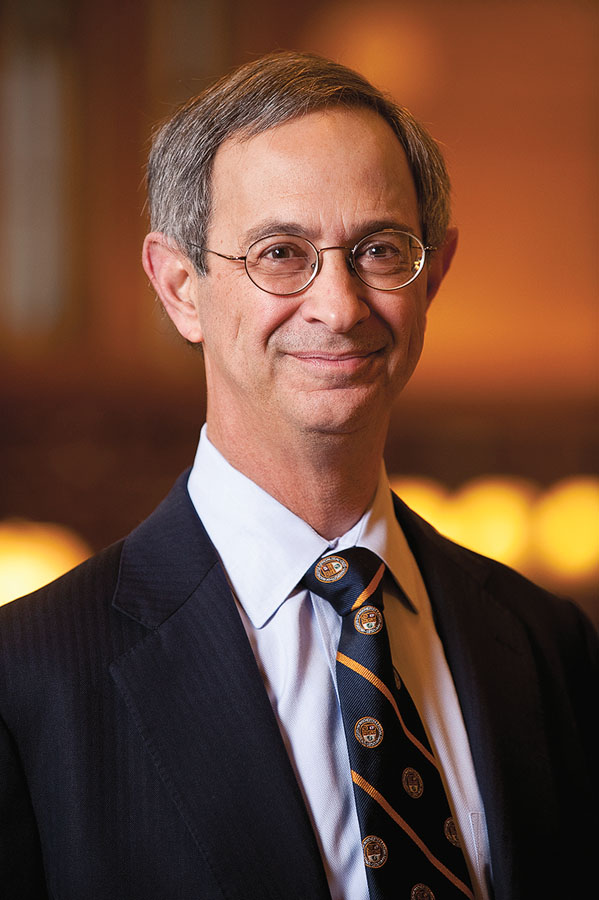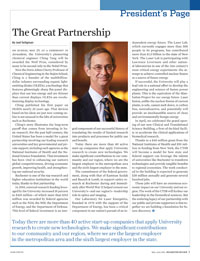President’s Page
 (Photo: Adam Fenster)
(Photo: Adam Fenster)On Sunday, May 29, at a ceremony in Jerusalem, the University’s pioneering chemical engineer Ching Tang will be awarded the Wolf Prize, considered by many to be second only to the Nobel Prize.
Now the Doris Johns Cherry Professor of Chemical Engineering in the Hajim School, Ching is a founder of the multibillion- dollar industry surrounding organic light-emitting diodes (OLEDs), a technology that features glisteningly sharp flat-panel displays that use less energy and are thinner than current displays. OLEDs are revolutionizing display technology.
Ching published his first paper on OLEDs nearly 25 years ago. That devices based on his ideas are just now coming online is not unusual in the labs of universities such as Rochester.
Ching’s story illustrates the long-term payoff that comes from investing in basic research. For the past half-century, the United States has been a model for a great partnership involving our leading research universities and key governmental and private support, including such agencies as the National Institutes of Health and the National Science Foundation. That investment has been vital to enhancing our nation’s global competitiveness, driving economic growth, improving health, and strengthening our national security.
Rochester is one of the top research and higher education institutions in the world today, thanks to that partnership.
In 2010, external research funding leveraged by the University increased 18 percent to $418 million—of which more than $313 million was awarded by federal agencies such as the NIH, the NSF, the Department of Energy, and the Department of Defense. This level of federal investment is an integral component of our successful history of translating the results of funded research into products and processes for public use and benefit.
Today there are more than 40 active start-up companies that apply University research to create new technologies. We make significant contributions to our community and our region, where we are the largest employer in the metropolitan area and the sixth largest employer in the state.
The commitment of the federal government, along with that of Eastman Kodak and Bausch & Lomb, to support optics research at Rochester during and immediately after World War II helped cement our University’s—and our region’s—leadership role in optics and imaging.
Our Laboratory for Laser Energetics, founded in 1970 with the support of the Department of Energy, has been a critical component in our nation’s pursuit of an independent energy future. The Laser Lab, which currently engages more than 500 people in its programs, has contributed more than $1.5 billion to the state of New York. The Laser Lab is participating with Lawrence Livermore and other national laboratories in one of the 21st century’s most critical energy experiments–the attempt to achieve controlled nuclear fusion as a source of future energy. If successful, the University will play a lead role in a national effort to develop the engineering and science of fusion power plants. This is the equivalent of the Manhattan Project for our energy future. Laser fusion, unlike the nuclear fission of current plants, is safe, cannot melt down, is carbon free, nonradioactive, and potentially will provide an inexhaustible source of clean and environmentally benign energy.
In April, we celebrated the grand opening of our new Clinical and Translational Science Building, a first-of-its-kind facility to accelerate the clinical applications of biomedical research. Thanks to a $40 million grant from the National Institutes of Health and $50 million in funding from New York, the CTSB will become a model for how state and federal support can leverage the talents of universities like Rochester to transform technologies and provide tangible benefits to regional economies. The work conducted in the building is expected to generate $30 million annually and generate several hundred jobs.
Those jobs will have an enormous economic impact on our University and our region. The work of the CTSB will further our leadership in the biomedical sciences. But the enduring legacy of our partnership with our public and private supporters is that together we are building a foundation for future discovery.

